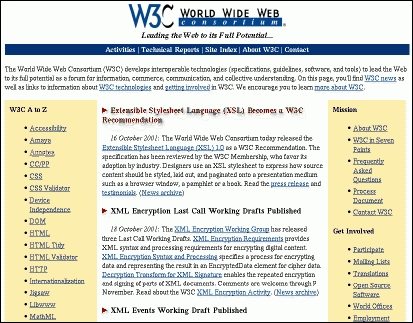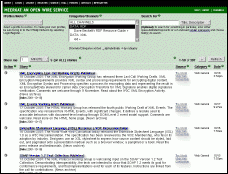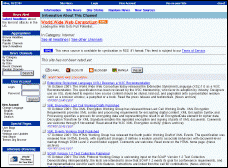6.5 RSS 1.0: RDF Site Summary
RSS 1.0 ("RDF Site Summary") is an RDF Vocabulary that provides a lightweight multipurpose extensible metadata description and syndication format. In short, RSS 1.0 is very powerful and extensible way of describing, managing and making available to very broad audiences relevant and timely information.
When you consider all of the information that that you accessed on the Web on a day-to-day basis; your schedule, to-do lists, news headlines, search results, "What's New", etc. the challenges for managing this information become daunting. It becomes increasingly difficult to manage this information and integrate this into a coherent whole as there the sources of and the diversity of this information increase. RSS 1.0 is an RDF vocabulary that allows the syndication of information, or metadata, and facilities the distribution and re-purposing of this data.
A Simple Example
The W3C home page is a primary point of contact with the public and serves in part to disseminate information about the deliverables of the Consortium. The center column of news items changes frequently. To support the timely dissemination of this information, the W3C Team has implemented an RDF Site Summary (RSS 1.0) news feed that makes the content in the center column available to news syndication sites.
Content aggregators syndicate countless sites all over the Web using RDF that looks like the following. The W3C site is only one of countless example of many such news feeds in RSS 1.0.
<?xml version="1.0" encoding="utf-8"?> <rdf:RDF xmlns:dc="http://purl.org/dc/elements/1.1/" xmlns:rdf="http://www.w3.org/1999/02/22-rdf-syntax-ns#" xmlns:rss="http://purl.org/rss/1.0/"> <rss:channel rdf:about="http://www.w3.org/2000/08/w3c-synd/home.rss"> <rss:title>The World Wide Web Consortium</rss:title> <rss:description>Leading the Web to its Full Potential...</rss:description> <rss:link>http://www.w3.org/</rss:link> <dc:date>2001-10-19T19:53:13Z</dc:date> <rss:items> <rdf:Seq> <rdf:li rdf:resource="http://www.w3.org/News/2001#item178"/> <rdf:li rdf:resource="http://www.w3.org/News/2001#item180"/> <rdf:li rdf:resource="http://www.w3.org/News/2001#item179"/> </rdf:Seq> </rss:items> <rss:item rdf:about="http://www.w3.org/News/2001#item178"> <rss:title>Extensible Stylesheet Language (XSL) Becomes a W3C Recommendation</rss:title> <rss:description>16 October 2001: The World Wide Web Consortium today released the Extensible Stylesheet Language (XSL) 1.0 as a W3C Recommendation. The specification has been reviewed by the W3C Membership, who favor its adoption by industry. Designers use an XSL stylesheet to express how source content should be styled, laid out, and paginated onto a presentation medium such as a browser window, a pamphlet or a book. Read the press release and testimonials. (News archive)</rss:description> <rss:link>http://www.w3.org/News/2001#item178</rss:link> <dc:date>2001-10-16</dc:date> </item> </rss:channel> </rdf:RDF>
This information in turn is syndicated to a variety of applications including different service aggregators, off-line readers, phones, PDAs, etc. Below for example is the W3C channel at two different commercial aggregators, Meerkat and NewsIsFree, each mirroring W3C's column of news.
RSS 1.0 provides a lightweight multipurpose extensible metadata description and syndication format that facilitates the effective distribution and aggregation of data.


